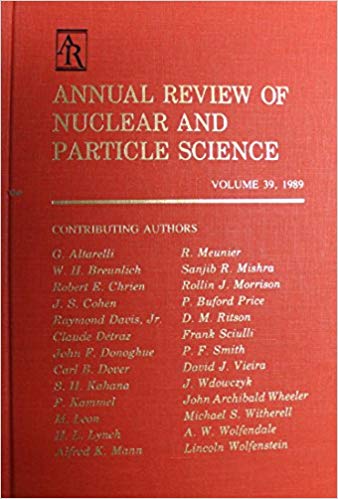High-Luminosity B Factory e+e− Colliders
IF 8.4
2区 物理与天体物理
Q1 PHYSICS, NUCLEAR
Annual Review of Nuclear and Particle Science
Pub Date : 2024-09-26
DOI:10.1146/annurev-nucl-113021-055740
引用次数: 0
Abstract
Three double-ring B factories—PEP-II, KEKB, and SuperKEKB—were built with asymmetric beam energies to produce high luminosity at the Υ(4S) resonance producing copious B mesons and associated particle physics data, delivered to their respective particle physics detectors, BaBar, Belle, and Belle II. In PEP-II and KEKB, the primary goal was achieved to make the first measurements of charge parity (CP) violation in decays in the B meson system. PEP-II and KEKB have finished beam operations, but particle data analysis continues. SuperKEKB is extending those measurements. The beam operation of SuperKEKB with Belle II has recently started. These three accelerators have pushed the state of the art of accelerators of two-ring colliders, including small beam emittances, small interaction point beam sizes, large stored beam currents, crab cavities, top-up injection with the detectors on, bunch-by-bunch feedbacks, crab waist operation, high beam–beam parameters, high peak luminosity, and high integrated luminosity.高亮度 B 工厂 e+e 对撞机
三个双环B工厂--PEP-II、KEKB和SuperKEKB--采用不对称束流能量建造,在Υ(4S)共振处产生高亮度,产生大量B介子和相关粒子物理数据,并输送到各自的粒子物理探测器--BaBar、Belle和Belle II。PEP-II和KEKB的主要目标是首次测量B介子系统衰变中的电荷奇偶性(CP)违反。PEP-II 和 KEKB 已经完成了光束运行,但粒子数据分析仍在继续。SuperKEKB 正在扩展这些测量。SuperKEKB 与 Belle II 的光束运行最近已经开始。这三台加速器推动了双环对撞机加速器的技术发展,包括小光束发射率、小相互作用点光束尺寸、大存储光束电流、蟹腔、探测器开启时的补加注入、逐束反馈、蟹腰运行、高光束-光束参数、高峰值光度和高综合光度。
本文章由计算机程序翻译,如有差异,请以英文原文为准。
求助全文
约1分钟内获得全文
求助全文
来源期刊
CiteScore
21.50
自引率
0.80%
发文量
18
期刊介绍:
The Annual Review of Nuclear and Particle Science is a publication that has been available since 1952. It focuses on various aspects of nuclear and particle science, including both theoretical and experimental developments. The journal covers topics such as nuclear structure, heavy ion interactions, oscillations observed in solar and atmospheric neutrinos, the physics of heavy quarks, the impact of particle and nuclear physics on astroparticle physics, and recent advancements in accelerator design and instrumentation.
One significant recent change in the journal is the conversion of its current volume from gated to open access. This conversion was made possible through Annual Reviews' Subscribe to Open program. As a result, all articles published in the current volume are now freely available to the public under a CC BY license. This change allows for greater accessibility and dissemination of research in the field of nuclear and particle science.

 求助内容:
求助内容: 应助结果提醒方式:
应助结果提醒方式:


